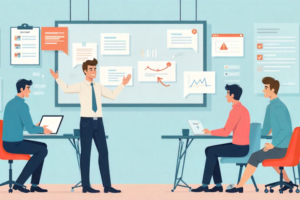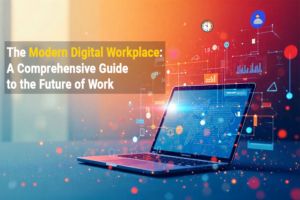
Digital workplace
Ultimate Guide To Digital Workplace: definition, features, benefits, challenges and best practices
Digital workplace is considered as an essential enabler of remote work, productivity, and innovation in the modern workforce. It allows employees to be connected to their tools and information, and allows every employee to access them at any time and on any device in order to share information and documents and to collaborate smoothly and efficiently from a distance.
The digital workplace is the use of digital tools, technologies and platforms to drive productivity, collaboration and communication within an organization. It includes a variety of software applications, devices and online services that enable employees to carry out their work remotely and efficiently.
Generally, digital workplace is an evolving concept that enables employees to work more efficiently, collaborate effectively and adapt to the changing business landscape.
Related :


Digital sovereignty: when public actors move from words to action

The Modern Intranet: A Key Challenge for Local Authorities

How to Improve Internal Communication in the Workplace

The Modern Digital Workplace: A Comprehensive Guide to the Future of Work
FAQ
You will find here Frequently Asked Questions about digital workplace with all the answers in one place.
What is a digital workplace?
- An evolution of the intranet
- A user centric digital experience
What Exactly Is a Digital Workplace?
The digital workplace is an overarching concept. It includes everything—from the software employees use to chat and share documents, to the platforms that integrate those tools, to the cultural processes that make work effective.
- It is not just technology, but also the way work is organized digitally.
- It enables people to stay productive no matter where they are (office, home, or on the go).
- It combines communication, collaboration, knowledge management, governance, and apps into one digital ecosystem.
In short: The digital workplace is your company’s digital headquarters.
What is Digital Workplace Software?
Digital workplace software refers to individual applications that perform specific tasks inside the larger ecosystem. Each of these tools is powerful in its own way, but on their own, they only solve one slice of the digital workplace puzzle.
What is a Digital Workplace Platform?
A digital workplace platform is a central hub that integrates multiple tools and capabilities into a single, unified environment. Instead of many disconnected apps, a platform reduces silos, offers consistency, and provides one go-to space for employees to get things done.
A digital workplace platform is the next level up. Instead of being one tool for one purpose, a platform is a central hub that integrates multiple tools and capabilities into a single, unified environment.
- It brings together communication, collaboration, knowledge sharing, governance, search, and apps.
- It reduces silos, so employees don’t waste time switching between 10 different tools.
- It’s extensible, meaning you can add plugins, APIs, and custom apps as your needs grow.
Think of it as the operating system for your digital office.
What is a Digital Workplace Solution?
A digital workplace solution combines tools, platforms, and strategic services to solve specific business problems. Beyond technology, solutions include consulting, implementation, and change management to make sure the digital workplace delivers real business outcomes.
A digital workplace solution goes one step further. It is not just about providing software or a platform—it’s about packaging technology with strategy, services, and implementation to solve a specific business problem.
- A solution may combine a platform, several integrated software tools, and professional services like training or change management.
- Solutions are often designed around use cases: frontline communication kits, hybrid onboarding portals, service desk knowledge hubs, or HR collaboration spaces.
In short: A digital workplace solution is a solution about achieving business outcomes, not just deploying tools.
What is a Digital Workplace Experience (DEX)?
The digital workplace experience is the human side. It reflects how employees actually feel when using the digital workplace—how easy it is, how fast it works, how well it supports their needs, and whether it makes their day-to-day work smoother or more frustrating. A positive DEX means higher engagement, productivity, and retention.
Finally, there is the digital workplace experience (DEX)—a critical, human-centered perspective.
- DEX is all about the employee’s lived experience of using the digital workplace.
- It’s not just about features, but about findability, speed, personalization, and ease of use.
A good DEX means tools are intuitive, friction is reduced, and employees feel empowered rather than frustrated.
What’s the Difference Between Digital Workplace Software, Platform, and Solutions?
Think of these four layers as different pieces of the same puzzle:
- Software → The building blocks. Small, focused tools designed to perform specific tasks.
- Platform → The foundation. A central hub that brings those tools together into one coherent system.
- Solutions → The blueprint in action. A tailored combination of technology and services aimed at solving a concrete business challenge.
- Experience (DEX) → The outcome. How employees actually perceive and use everything above—the “human” side that determines adoption, satisfaction, and success.
👉 In simple terms:
- Software gives you pieces.
- Platforms give you the structure.
- Solutions give you the strategy.
- Experience defines the success.
What does digital workplace really mean?
The digital workplace is the virtual, digital equivalent of the physical workplace. It is a holistic user-centered solution used to connect, engage, and empower employees. Through an employee-centered hub, it encompasses a set of tools, applications, and platforms for a complete work experience.
Why Does the Digital Workplace Matter?
The digital workplace is no longer just a “nice-to-have” — it has become a strategic necessity for organizations of all sizes. Work is hybrid, distributed, and fast-changing, and employee expectations are higher than ever. A modern digital workplace ensures productivity, engagement, and resilience.
Here are the main reasons why it matters today:
- Productivity + Satisfaction: Happy employees are more productive when they have the right tools.
- Hybrid Work Ready: Keeps teams connected anywhere, anytime.
- Consumer-Grade Tech: Employees expect smooth, modern digital experiences.
- Collaboration: Breaks down silos and fosters teamwork.
- Data & Wellbeing: Provides insights to prevent burnout.
- Innovation & Efficiency: Cuts app-switching, boosts focus.
- Culture & Engagement: Strengthens company culture.
- Agility & Flexibility: Helps organizations adapt quickly.
- Stability: Protects against vendor changes.
➝ See the full explanation of why the digital workplace matters
What types of digital workplace tools exist?
The digital workplace isn’t a single app but an ecosystem of platforms that together support communication, collaboration, and productivity. Each category plays a unique role in shaping the employee experience.
Main categories include:
- Intranet & Employee Experience: Modern hubs for news, resources, and culture.
- Collaboration Hubs: Real-time chat, video, and teamwork spaces.
- Productivity Suites: Core apps (docs, email, spreadsheets) enhanced with AI.
- Knowledge & Search: Wikis, semantic search, and AI-powered recommendations.
- Work Orchestration: Task, project, and goal alignment platforms.
- All-in-One Platforms: Unified environments reducing app fragmentation.
What are the benefits of digital workplace software?
A well-designed digital workplace goes beyond apps — it’s the foundation of modern work. It improves productivity, culture, and resilience while reducing friction for employees.
Key benefits include:
- Productivity: Reduces app-switching and keeps employees in flow.
- Communication: Delivers clear, targeted, and role-based updates.
- Collaboration: Enables seamless teamwork across locations.
- Knowledge Retention: Captures and shares expertise effectively.
- Data-Driven Insights: Improves employee experience (DEX) and reduces burnout.
- Governance & Security: Protects data and ensures compliance.
- Culture & Connection: Builds engagement and belonging.
- Onboarding & Agility: Speeds up hiring integration and adaptation.
- Resilience: Ensures stability in a shifting tech landscape.
How to launch an effective Digital Workplace?
- Understand users’ needs
- Identify your digital workplace ambassadors
- Build the digital workplace brand
- Training and onboarding
- Plan the big day
How to be a good digital workplace manager?
- Analytical skills and approach
- Focus on employees
- Communication and strategic vision
➝ The success of a digital workplace project depends on a number of factors
Why digital workplace security is important?
When first deploying a digital workplace, businesses often look to integrate it with legacy systems and third-party applications. This results from the growing willingness of employees to use their own devices and apps at work.
According to an intel study, 61% of Gen Y employees and 50% of employees over the age of 30 believe that the technology tools they use in their everyday lives are more effective than those provided by their employers’ IT departments. To counter the phenomenon known as “shadow IT” and to ensure the security of personal information and sensitive data, IT teams have progressively leaned towards holistic digital workplace solutions that can group a host of features and that are easily integrated and securely accessible through two-factor authentication and single sign-on.
How do you secure your Digital Workplace?
Here are some best practices to minimise security threats in digital workplaces:
- Develop a cybersecurity policy
- Continuous training
- Control access to information
- Be sure to update regularly
loreum
Lorem ipsum dolor sit amet, consectetur adipiscing elit. Ut elit tellus, luctus nec ullamcorper mattis, pulvinar dapibus leo.Lorem ipsum dolor sit amet, consectetur adipiscing elit. Ut elit tellus, luctus nec ullamcorper mattis, pulvinar dapibus leo.Lorem ipsum dolor sit amet, consectetur adipiscing elit. Ut elit tellus, luctus nec ullamcorper mattis, pulvinar dapibus leo.Lorem ipsum dolor sit amet, consectetur adipiscing elit. Ut elit tellus, luctus nec ullamcorper mattis, pulvinar dapibus leo.Lorem ipsum dolor sit amet, consectetur adipiscing elit. Ut elit tellus, luctus nec ullamcorper mattis, pulvinar dapibus leo.Lorem ipsum dolor sit amet, consectetur adipiscing elit. Ut elit tellus, luctus nec ullamcorper mattis, pulvinar dapibus leo.Lorem ipsum dolor sit amet, consectetur adipiscing elit. Ut elit tellus, luctus nec ullamcorper mattis, pulvinar dapibus leo.Lorem ipsum dolor sit amet, consectetur adipiscing elit. Ut elit tellus, luctus nec ullamcorper mattis, pulvinar dapibus leo.Lorem ipsum dolor sit amet, consectetur adipiscing elit. Ut elit tellus, luctus nec ullamcorper mattis, pulvinar dapibus leo.Lorem ipsum dolor sit amet, consectetur adipiscing elit. Ut elit tellus, luctus nec ullamcorper mattis, pulvinar dapibus leo.
Accordéon #2
Lorem ipsum dolor sit amet, consectetur adipiscing elit. Ut elit tellus, luctus nec ullamcorper mattis, pulvinar dapibus leo.Lorem ipsum dolor sit amet, consectetur adipiscing elit. Ut elit tellus, luctus nec ullamcorper mattis, pulvinar dapibus leo.Lorem ipsum dolor sit amet, consectetur adipiscing elit. Ut elit tellus, luctus nec ullamcorper mattis, pulvinar dapibus leo.Lorem ipsum dolor sit amet, consectetur adipiscing elit. Ut elit tellus, luctus nec ullamcorper mattis, pulvinar dapibus leo.Lorem ipsum dolor sit amet, consectetur adipiscing elit. Ut elit tellus, luctus nec ullamcorper mattis, pulvinar dapibus leo.Lorem ipsum dolor sit amet, consectetur adipiscing elit. Ut elit tellus, luctus nec ullamcorper mattis, pulvinar dapibus leo.Lorem ipsum dolor sit amet, consectetur adipiscing elit. Ut elit tellus, luctus nec ullamcorper mattis, pulvinar dapibus leo.Lorem ipsum dolor sit amet, consectetur adipiscing elit. Ut elit tellus, luctus nec ullamcorper mattis, pulvinar dapibus leo.Lorem ipsum dolor sit amet, consectetur adipiscing elit. Ut elit tellus, luctus nec ullamcorper mattis, pulvinar dapibus leo.Lorem ipsum dolor sit amet, consectetur adipiscing elit. Ut elit tellus, luctus nec ullamcorper mattis, pulvinar dapibus leo.
Titre d’accordéon
Lorem ipsum dolor sit amet, consectetur adipiscing elit. Ut elit tellus, luctus nec ullamcorper mattis, pulvinar dapibus leo.Lorem ipsum dolor sit amet, consectetur adipiscing elit. Ut elit tellus, luctus nec ullamcorper mattis, pulvinar dapibus leo.Lorem ipsum dolor sit amet, consectetur adipiscing elit. Ut elit tellus, luctus nec ullamcorper mattis, pulvinar dapibus leo.Lorem ipsum dolor sit amet, consectetur adipiscing elit. Ut elit tellus, luctus nec ullamcorper mattis, pulvinar dapibus leo.Lorem ipsum dolor sit amet, consectetur adipiscing elit. Ut elit tellus, luctus nec ullamcorper mattis, pulvinar dapibus leo.Lorem ipsum dolor sit amet, consectetur adipiscing elit. Ut elit tellus, luctus nec ullamcorper mattis, pulvinar dapibus leo.Lorem ipsum dolor sit amet, consectetur adipiscing elit. Ut elit tellus, luctus nec ullamcorper mattis, pulvinar dapibus leo.Lorem ipsum dolor sit amet, consectetur adipiscing elit. Ut elit tellus, luctus nec ullamcorper mattis, pulvinar dapibus leo.Lorem ipsum dolor sit amet, consectetur adipiscing elit. Ut elit tellus, luctus nec ullamcorper mattis, pulvinar dapibus leo.Lorem ipsum dolor sit amet, consectetur adipiscing elit. Ut elit tellus, luctus nec ullamcorper mattis, pulvinar dapibus leo.
Titre d’accordéon
Lorem ipsum dolor sit amet, consectetur adipiscing elit. Ut elit tellus, luctus nec ullamcorper mattis, pulvinar dapibus leo.Lorem ipsum dolor sit amet, consectetur adipiscing elit. Ut elit tellus, luctus nec ullamcorper mattis, pulvinar dapibus leo.Lorem ipsum dolor sit amet, consectetur adipiscing elit. Ut elit tellus, luctus nec ullamcorper mattis, pulvinar dapibus leo.Lorem ipsum dolor sit amet, consectetur adipiscing elit. Ut elit tellus, luctus nec ullamcorper mattis, pulvinar dapibus leo.Lorem ipsum dolor sit amet, consectetur adipiscing elit. Ut elit tellus, luctus nec ullamcorper mattis, pulvinar dapibus leo.Lorem ipsum dolor sit amet, consectetur adipiscing elit. Ut elit tellus, luctus nec ullamcorper mattis, pulvinar dapibus leo.Lorem ipsum dolor sit amet, consectetur adipiscing elit. Ut elit tellus, luctus nec ullamcorper mattis, pulvinar dapibus leo.Lorem ipsum dolor sit amet, consectetur adipiscing elit. Ut elit tellus, luctus nec ullamcorper mattis, pulvinar dapibus leo.Lorem ipsum dolor sit amet, consectetur adipiscing elit. Ut elit tellus, luctus nec ullamcorper mattis, pulvinar dapibus leo.Lorem ipsum dolor sit amet, consectetur adipiscing elit. Ut elit tellus, luctus nec ullamcorper mattis, pulvinar dapibus leo.
